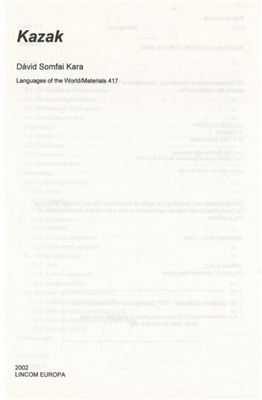Kara D.S. Kazak. - Lincom Europa, 2002. - 61 p.
Kazak is a Turkic language, it is spoken by some 11 million people in Kazakstan and its neighboring countries (Russia, Mongolia, China, Uzbekistan, Turkmenistan). It is spoken on a huge territory between Tibet and the Volga River, Siberia and the Kara-Kum desert. Kazak belongs to the Kypchak group of Turkic Languages, which was once the "Lingua Franca of the weste part of the Mongol Empire. For this reason Kazak have strong ties with other Turkic languages of Inner and Central Asia, Kyrgyz, Kazan-Tatar (Volga-Bulgar), Uzbek etc.
This present Material of the Kazak language is an up-to-date grammar, based on the author's ten-year research among the Kazaks of Kazakstan and other neighboring countries. During that time the author himself mastered the language and paid special attention to colloquial Kazak and the usage of the changing language. In this present work he summarized up his observation, especially about TAM (Tense-Mood-Aspect) Categories of the Kazak Verb Morphology and Auxiliary Verb Formations, which are the basic aspects of understanding colloquial Kazak, as well as Kazak literature. The author also gives numerous examples to illustrate the usage of these morphological aspects. The phonology part explains some phonetic changes that can be observed only in spoken Kazak, but writing does not indicate them.
Kazak is a Turkic language, it is spoken by some 11 million people in Kazakstan and its neighboring countries (Russia, Mongolia, China, Uzbekistan, Turkmenistan). It is spoken on a huge territory between Tibet and the Volga River, Siberia and the Kara-Kum desert. Kazak belongs to the Kypchak group of Turkic Languages, which was once the "Lingua Franca of the weste part of the Mongol Empire. For this reason Kazak have strong ties with other Turkic languages of Inner and Central Asia, Kyrgyz, Kazan-Tatar (Volga-Bulgar), Uzbek etc.
This present Material of the Kazak language is an up-to-date grammar, based on the author's ten-year research among the Kazaks of Kazakstan and other neighboring countries. During that time the author himself mastered the language and paid special attention to colloquial Kazak and the usage of the changing language. In this present work he summarized up his observation, especially about TAM (Tense-Mood-Aspect) Categories of the Kazak Verb Morphology and Auxiliary Verb Formations, which are the basic aspects of understanding colloquial Kazak, as well as Kazak literature. The author also gives numerous examples to illustrate the usage of these morphological aspects. The phonology part explains some phonetic changes that can be observed only in spoken Kazak, but writing does not indicate them.

